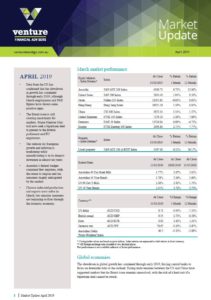The Pulse

- Data from the US has confirmed that the slowdown in growth has continued through early 2019, although March employment and PMI figures have shown some positive signs
- The Brexit issue is still creating uncertainty for markets. Prime Minister May will now seek a bipartisan deal to present to the British parliament and EU negotiators
- The outlook for European growth and inflation is weakening while manufacturing is in its deepest downturn in almost six years
- Australia’s federal budget contained few surprises, with the return to surplus and tax measures largely anticipated by the market
- Chinese industrial production and exports were softer in March, but stimulus measures are beginning to flow through the domestic economy.
Global economies
The slowdown in global growth has continued through early 2019, forcing central banks to focus on downside risks to the outlook. Easing trade tensions between the US and China have supported markets but the Brexit issue remains unresolved, with the risk of a hard exit if a bipartisan deal cannot be struck.
Australia
With the election coming up in May, the federal budget was handed down a month before the regular budget season, presenting tax measures to please key voter groups, a further boost to infrastructure spending, and the much-vaunted return to surplus.
US
The slowdown in US growth in the early months of 2019 has been confirmed by incoming data and follows a sharp downturn in the last quarter of 2018. With inflation slipping back below the Fed’s target, markets have dramatically shifted their expectations for the next interest rate move, with a cut to the funds rate firming as a possibility.
Europe
The ECB sharply cut its expectations for growth from 1.7% to 1.1% for 2019 and from 1.7% to 1.6% for 2020. ECB President Draghi referred to weak data from the manufacturing sector arising from a slowdown in international demand and specific factors, including Brexit, ongoing disruption in the auto industry, and the US-China trade dispute.
China
The news out of China has been slightly more positive over the past month, with March PMI figures improving and retail sales growth stabilising. Certainly Chinese shares have been more upbeat, rising 5.5% in March and more than 28.7% over the quarter.
Asia Region
The Nikkei Japan PMIs paint a mixed picture, with the manufacturing sector in contraction due to weak global and domestic manufacturing demand, while the services sector saw new business rising at the fastest rate in six years. The sales tax rise from 8.0% to 10.0% due in October and weakened global growth both present risks to the downside.